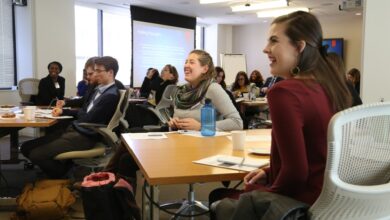Students Wrote About Allegations Against a Professor. Then the Articles Disappeared.

[ad_1]
Sierra Dyson was checking her email when she saw the letter. It was addressed simply to the Texan News Service, one of Tarleton State University’s student publications. Dyson is its top editor, so she started reading.
A lawyer representing a former Tarleton professor was demanding the removal of a series of articles published in 2018. The lawyer’s client, Michael Landis, was “prepared to take any and all legal action necessary to lessen and reverse the damage” the articles had caused, the lawyer wrote.
“The Statements disseminate false accusations of sexual harassment against our client,” the letter said. Though the university had investigated Landis and determined he “had not sexually harassed his accusers and did not create a hostile educational environment, you intentionally buried that information in the last several paragraphs.”
The newspaper had reported that several undergraduate students had submitted complaints about Landis, an assistant professor of history, to the university’s Title IX office. The newspaper continued to follow the story when a university investigation found that while Landis had not sexually harassed the students or created a hostile environment, his behavior was “inappropriate” and an administrator had recommended he be fired. Landis left the university of his own volition.
Dyson thought someone besides her should have a look at the letter. She took it to the chair of the communication-studies department, which oversees the publication.
But Dyson wasn’t too worried. In Texas, the statute of limitations for defamation is only one year, and these stories were three years old. She felt sure the university would not cave to a threatening letter but would stand up for careful reporting on an important topic written by a top student. This was a professor, after all, whose termination the administration had recommended. She felt sure administrators would now stand up for two of the core values that they so often espouse to their students: leadership and integrity. Wouldn’t they?
In the mid-2000s, a new professor named Dan Malone pulled up Tarleton’s campus crime reports — reports that colleges are required to make under the Clery Act — and showed them to students in his class. Malone, who had shared the 1992 Pulitzer Prize in Investigative Reporting for a Dallas Morning News series on police misconduct, knew a lot about how to get documents from public institutions. He was teaching his students about what was available.
When reviewing the data, one of Malone’s students suspected the university, in Stephenville, Tex., must be underreporting campus crimes. Under Malone’s guidance, she and her classmates filed requests for on-campus police reports and found 10 “sex offenses” that had been reported to the Tarleton Police Department, but not to the Department of Education. They published a story in The J-TAC, the university’s official student publication, which led to a federal investigation and a $137,000 fine for Tarleton. (It was later reduced to $27,500, then raised to $110,000.)
Communication-studies professors founded Texan News Service a few years later as “a laboratory for student journalists,” said Charles Howard, a former chair of the department. The publication has put out different products over the years and is now a website, newspaper, and weekly broadcast on YouTube. “We were way more assertive than anybody at Tarleton had ever been before,” Howard said.
In 2018 college newspapers across the country were asserting themselves amid the #MeToo movement. Students, faculty members, staff, and alumni were turning to their campus publications to report abuses they’d suffered from university employees in positions of power.
At the Texan News Service, the editor that year was Quanecia Fraser, a dean’s-list student focused on journalism and broadcasting whom Malone, then the publication’s adviser, recognized as a talented reporter. “One night I’m going to turn on CBS News and she’s going to be delivering it,” Malone said. “She’s really good.”
Fraser had learned that several Tarleton students had stories about Landis. One of those students had received a text message from Landis proposing “dinner, drinks & movies” while his wife was away. The Texan News Service published a screenshot of the conversation. Fraser reported on the students’ accounts and the Title IX investigation. Eight women made complaints about Landis, according to her reporting, saying he invited them to his house or to have a drink with him even though at least two were under age.
Landis eventually left Tarleton in 2018, according to his CV. On his way out, he tried to clear his name by writing letters to prominent women scholars in his field, The Chronicle previously reported. They were met with derision.
Fraser graduated and is now a reporter and anchor at KETV, the ABC affiliate in Omaha, Neb. She was a commencement speaker at her 2019 graduation from Tarleton. Fraser was unable to comment in time for this article’s publication.
Vannoy and Dyson listened quietly while Eric V. Morrow, dean of the College of Liberal and Fine Arts, explained that the Texan News Service’s status as part of the communication-studies department meant that the publication lacked the independence of The J-TAC. The university, and therefore the Texas A&M system that it’s a part of, could be held responsible for what the Texan News Service publishes, he told the students. An A&M system spokesman declined to comment for this article.
“Right now, the way it’s looked at is that the university would be liable,” Morrow said in the meeting, according to a recording of the conversation that was shared with The Chronicle. Morrow did not respond to The Chronicle’s request for an interview. The Texan News Service, he said, “is not set up in a way that would protect both the university as well as give TNS the opportunity to do what it does as student journalism without the infringement of the institution.”
It was an unfortunate trend in higher education, he said, that some universities seek to avoid negative publicity by trying to intervene in the work done by campus newspapers. He wanted to help the Texan News Service become independent — and had already started this process, until the pandemic halted those efforts — but the fact remained that, right now, the publication was part of the university.
“If they move forward with a lawsuit it will take time and resources that would come from Tarleton,” Morrow said.
As she listened, Dyson began to realize that the university might not back the publication. They might tell her to take the articles down. After almost 10 minutes, she spoke up. There was something that didn’t make sense to her.
“Can I interject?” she asked. “I have a couple of questions.”
“I looked at the Texas penal code 16.002, and it says all defamation cases must be filed within a year of publication in the State of Texas,” she told the dean. “Are we ignoring the fact that this could be them just trying to scare a whole bunch of college students?” (“A person must bring suit for malicious prosecution, libel, slander, or breach of promise of marriage not later than one year after the day the cause of action accrues,” the statute holds.)
The dean didn’t see it that way. He further explained the importance of separating the publication from the university.
Vannoy was also starting to see where this was going. He worried about his publication’s reputation and what taking down the articles would mean for Quanecia Fraser.
“If we take it down,” he told the dean, “not only are we letting down that student, we’re letting down the Texan News Service and we’re letting down Tarleton as a whole and as a student body.”
Morrow threw out some hypothetical numbers. It might cost $100,000 to defend this, but only $60,000 to go another route. Would it really help the Texan News Service to spend the extra money to fight?
That’s when Dyson knew they’d lost.
“We had an article that actually meant something,” Vannoy told the dean.
The conversation went on for an hour. In the end, Morrow told them not to take down the articles yet. He asked Dyson to first find out if it was even possible to do so.
But the next day, Morrow sent Dyson an email.
“I received the following directive from the university administration,” he wrote. “Please have TNS remove all of the articles/videos referenced in the attached letter.” The letter from Landis’s lawyer was attached to the email.
Dyson removed the articles about Landis. A few days later, the dean asked for the removal of another article, published several months after the others, about a policy change at the Texas A&M University system. Under the new policy, university employees were prohibited from pursuing relationships with undergraduate students, according to the article. The story mentioned Landis, and it was mentioned in his lawyer’s letter. As of Tuesday, the article was still online.
The professors who had overseen the Texan News Service were outraged.
“The university should be extremely proud of the work Quanecia Fraser did and Texan News has done over the last 15 years in reporting on incidents, allegations of sexual harassment, and worse,” Malone said. “If that’s not what journalism is about, shining the light in darkness, then I don’t know what is.”
Another former journalism instructor at the university, Kathryn Jones, who helped found the Texan News Service and is married to Malone, oversees the Society of Professional Journalists’ Texas and Oklahoma chapters. She said that in her time working with the organization, she had never seen anything she considered as egregious as what Tarleton had done.
“We see universities pushing back against campus news all the time, threatening to pull back resources,” she said. Even so, she “had never seen a university try to erase history.”
Vannoy could understand from a business perspective why the university had ordered that the articles be removed, he said in an interview with The Chronicle. But he was disappointed that campus officials didn’t see the value in fighting back.
“I don’t think they understood the importance of those articles,” he said. “And understood why we resisted taking them down.”
Dyson was “utterly disappointed.” In an interview with The Chronicle, she referenced two of Tarleton’s core values: leadership and integrity. She thought about other stories she’d published that didn’t necessarily cast the university in a good light. Now, she wondered when the university would ask her to take down those as well.
[ad_2]
Source link






